Previously I wrote about why HIT or HIIT training beats threshold and tempo work on a like-for-like basis. You can read that blog here. I also explained why HIT has hidden benefits physiologically. That blog is here.
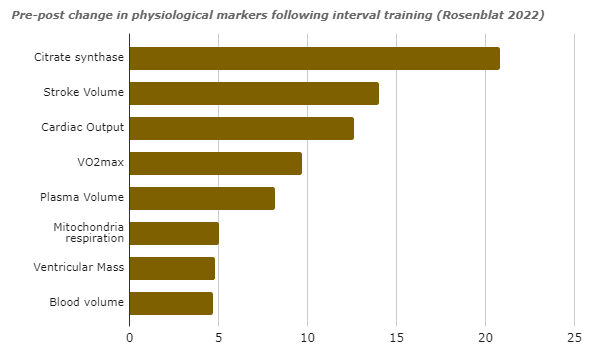
Today I am going to look at perfecting the interval session, digging into how long, how many, and how intense you should train for….and results appear to depend on whether you are doing SPRINT or V02max (HIIT) intervals:
Sprints (SIT) eg 8 sprints per workout @ 30s on and 2min off
VO2 HIIT eg 4 x 4min V02 max efforts with 2mins rest

Recall that Seiler and colleagues compared the effects of three different formats of long intervals (4x4m or 4x8m or 4x16m sessions with 2mins rest) over 7 weeks (link).
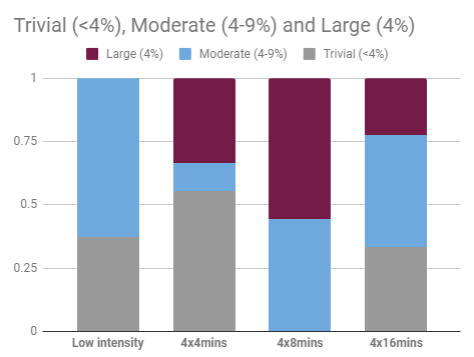
VO2 max improved with 10.4%, 6.5%, 5.6% and 3.4% in the 4×8, 4×16, 4×4 and low-intensity group, respectively; possibly with most improvement in the 4x8mins.
However this was only one study, with the same number of intervals, same rest, and same duration….so we don’t know if these variables make a difference.
Since then a lot more data has appeared and been summarized in several meta-analyses by Rosenblat’s group as follows…..
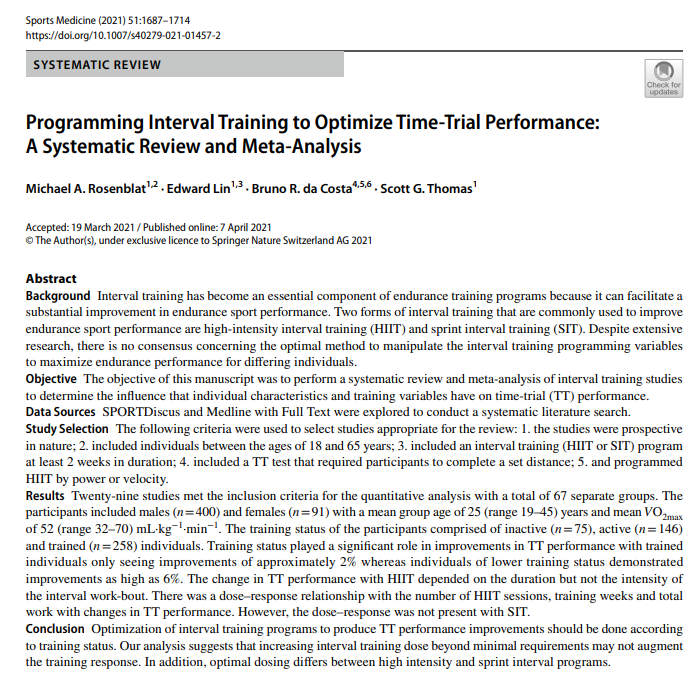
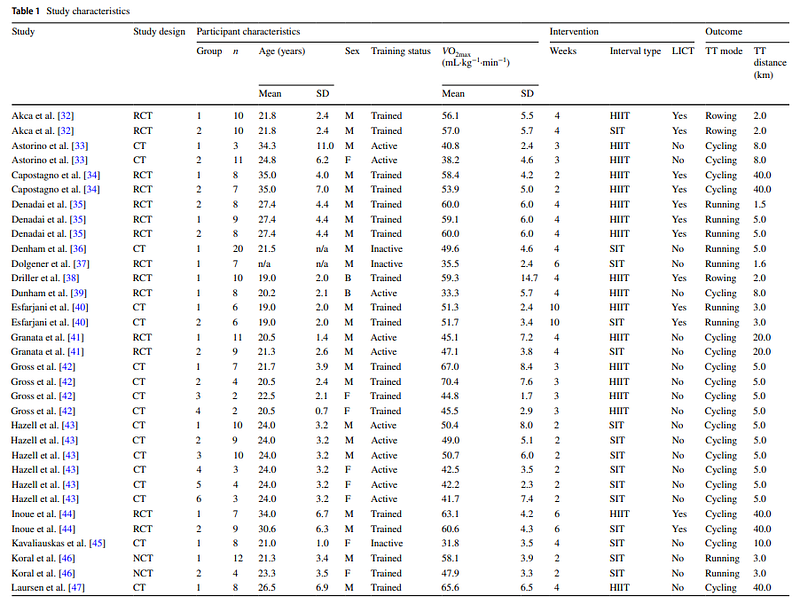
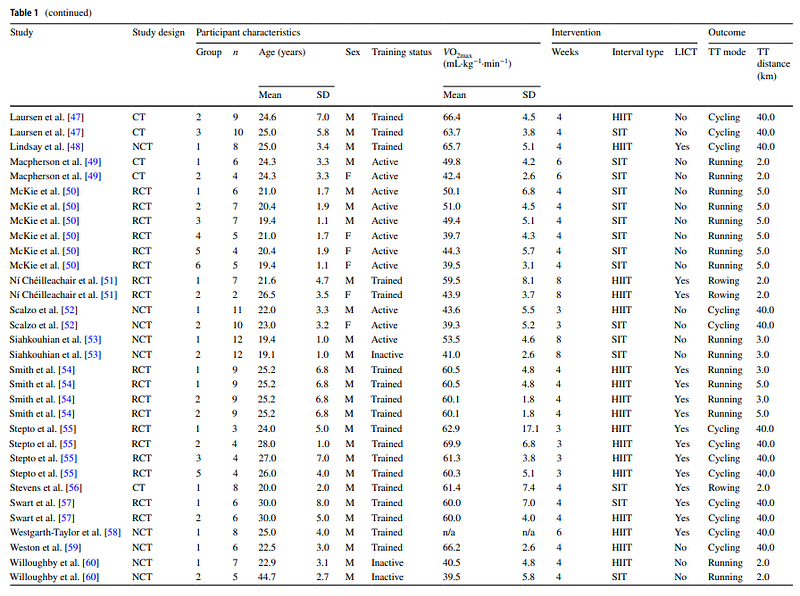
…and you can download the entire dataset here (LINK)
………………………..But what does it show?
===== Effect of Intensity =====
The first surprise from this data is for HIIT , then interval intensity itself did not have a significant effect (or any effect at all).
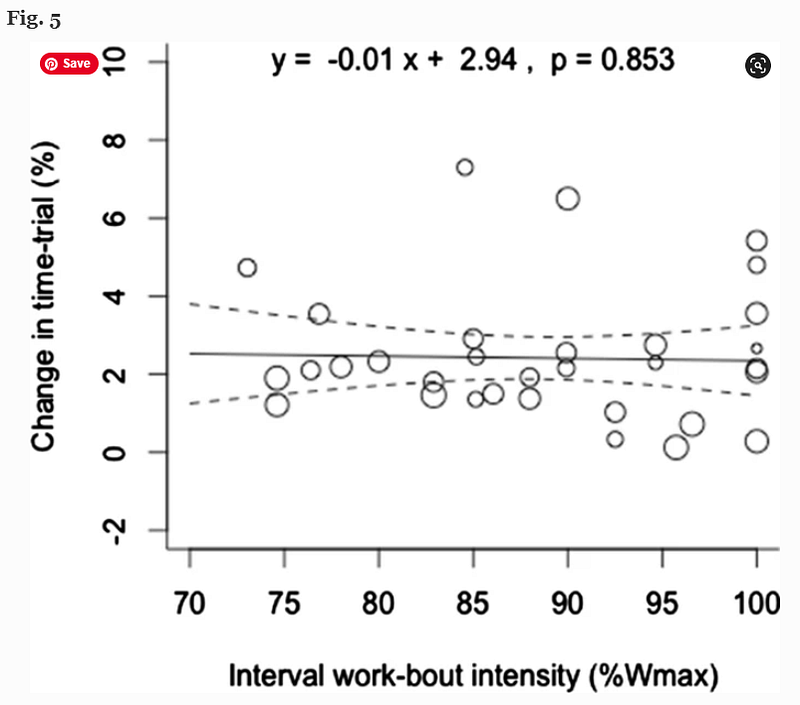
This might mean that anything over 75% of VO2max is ok, or it might be that higher intensity is balanced by less duration. As SIT was performed at max intensity, it would be useful to compared HIT and SIT. Also an older study by Helgerud et al. (2007) showed that HIIT at high intensity *did* induced greater effects on VO2max than the same training volume at lower intensity. as did previous meta-analyses (Bacon, Carter, Ogle, & Joyner, 2013; Milanovic et al., 2015)……
===== What About HIIT vs SIT? =====
We looked at this before but now have additional data from at least 7 groups (Balto & Helgerud, 2019; Trane & Helgerud, 2018; Esfarjani & Laursen, 2007; Laursen et al , 2002; Lunt et al., 2014; Lee et al, 2017, Naves et al., 2018) who have directly compared HIIT and SIT on VO2max . There is also a brand new meta-analysis by Boullosa (link) although they grouped HIIT with MICT/continuous.
Laursen et al. (2002) found HIIT to be significantly more effective than SIT at improving VO2max (8.1% vs 3.0%) in trained cyclists
Balto and Helgerud (2019) found HIIT to be significantly more effective compared to SIT (7.9 vs 1.6 % change in VO2max) in trained females. They also found threshold performance (3000m) improved by 5.7% after SIT and 5.7% after HIIT and sprint (300m) improved by 5.1% after HIIT and by 6.4% after SIT.
The remainder found no difference between groups (Esfarjani & Laursen, 2007; Lunt et al., 2014; Trane and Helgerud, 2018) found no difference in VO2max-improvement between groups
New data in the thesis of Anders Boye examined 23 trained athletes who did 10×30-second SIT or 4×4-minute HIIT for 3days/wk for 8 wk. He found HIIT resulted in significantly larger improvement in absolute VO2max, compared to SIT (3.6% vs -0.5%, respectively) but SIT improved anaerobic capacity (9.5%).
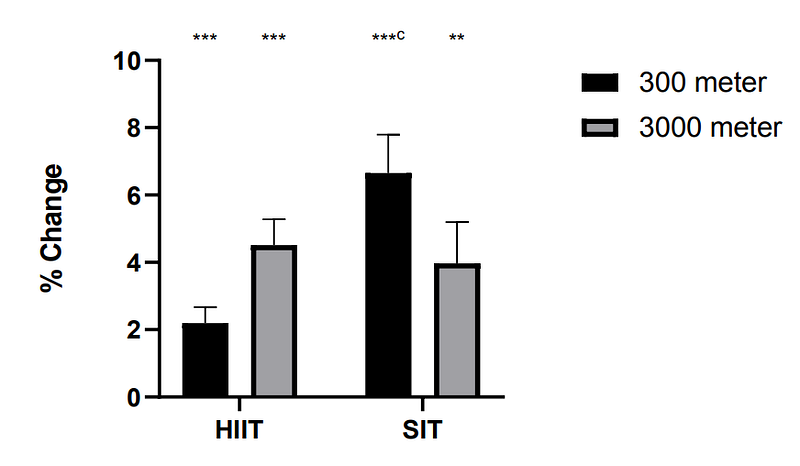
Further, both HIIT and SIT improved sprint and threshold performance but SIT favoured sprints (6.7% vs 2.2% ) and HIIT favoured threshold (4.3% vs 3.9%).
=====Interval Duration =====
A second surprise from the Rosenblat data was there was no effect of interval duration on change in TT performance except in trained participants; in other words any duration of interval training was beneficial in beginners, but sadly longer intervals may be needed in athletes.
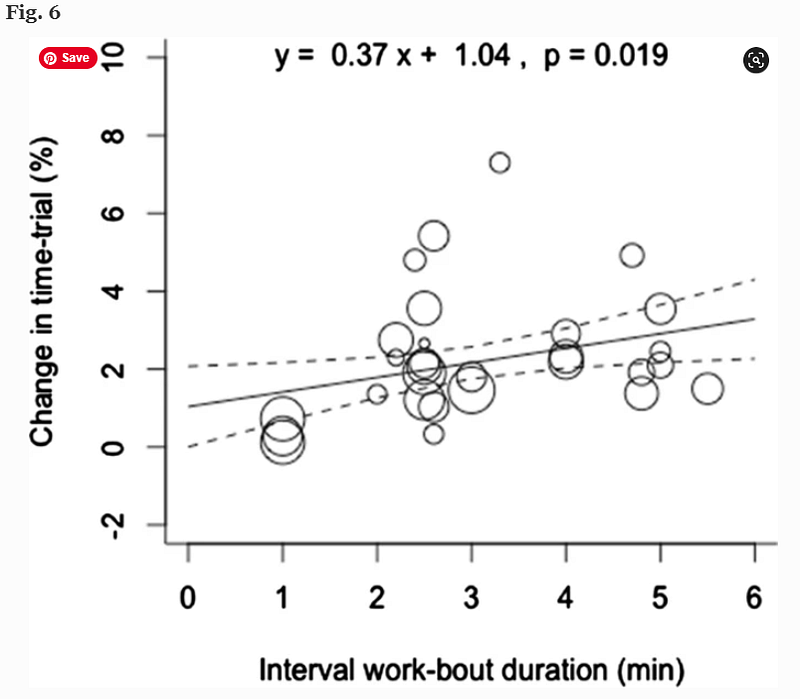
Recall that Seiler et al., 2013 found that a larger volume of HIIT, represented by 4×8-minute intervals (90% of HRmax) induced even greater effects on VO2max than 4×4-minute intervals (but also more than 4×16 @ 88% of HRmax; so likely duration has a ceiling
===== Recovery Periods =====
Active individuals demonstrated a greater improvement in TT performance following longer recovery; with optimal recovery duration equalling approximately 50% of the work-bout.
===== Interval Repetitions =====
There was no effect of number of interval repetitions following SIT but there was a slight decline in performance in trained individuals for more than five repetitions following HIIT.
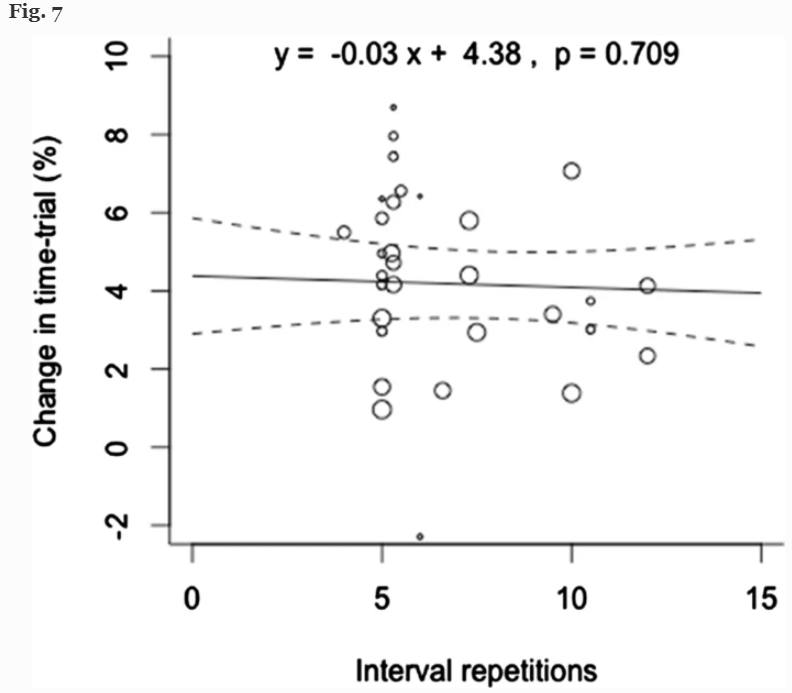
===== Total Sessions / Sessions Per Week =====
There was a 1.5% greater improvement in TT performance when individuals performed three HIIT sessions per week compared to two sessions (but no effect in SIT)
The total number of HIIT sessions as well as number of HIIT training weeks had a strong influence on changes in TT performance but again effects were not seen in SIT.
Summary
For beginners, any combination of HIIT or SIT is beneficial and effects will be quite large.
For trained individuals and athletes, somewhat longer HIIT with more workouts per week and longer plans are better *but* with appropriate rest.
Intensity of each session had a small effect and seems to depend on purpose. HIIT resulted in significantly larger improvement in aerobic capacity and VO2max but SIT preferentially improved anaerobic capacity (9.5%). Similarly for performance, HIIT benefits threshold work and SIT benefits sprint work, but both are effective.
Practical Recommendations
For beginners, start with a HIIT or SIT plan which starts relatively easy and builds very gradually because burn-out (or loss of motivation) is a major concern.
For trained individuals, start with a HIIT or SIT plan which starts moderately because injury is a major concern but the plan should have reasonable volume and adequate rest.
Beginners HIIT eg 3 x 3min V02 max efforts with 2mins rest, twice a week for 6 weeks.
Intermediate HIIT eg 4 x 4min V02 max efforts with 2mins rest, two times a week for 8 weeks.
Advanced HIIT eg 5 x 5min V02 max efforts with 2.5mins rest, 2–3 times a week for 12weeks.
Beginners SIT: 4 sprints @ 30s on and 4min off twice a week for 6 weeks.
Intermediate SIT: 6 sprints @ 30s on and 3min off twice a week for 8 weeks.
Advanced SIT: 8 sprints @ 30s on and 2min off 2–3 times a week for 12weeks.
Or You can work out exactly what to do using our calculator (link)
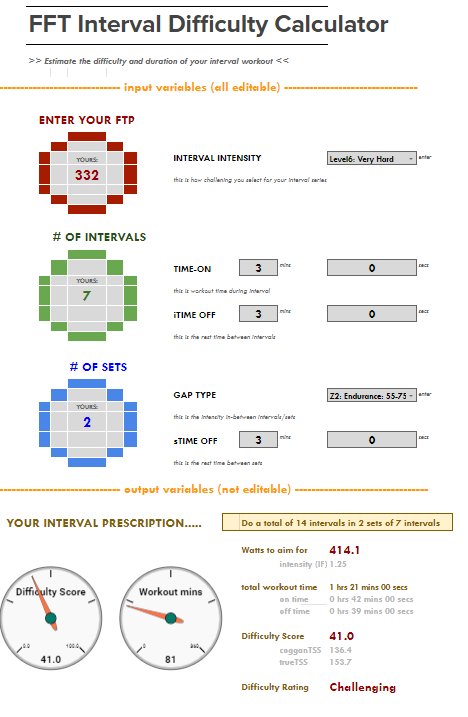
Citation
Rosenblat, M.A., Lin, E., da Costa, B.R. et al. Programming Interval Training to Optimize Time-Trial Performance: A Systematic Review and Meta-Analysis. Sports Med 51, 1687–1714 (2021)
Rosenblat MA et al Effect of Interval Training on the Factors Influencing Maximal Oxygen Consumption: A Systematic Review and Meta-Analysis. Sports Med. 2022 Jan 18. Epub ahead of print. PMID: 35041180.
Anders Johan Nesheim Boye Aerobic High-Intensity Interval Training Improve VO2max More Than Sprint Interval Training Master’s thesis in Exercise Physiology Supervisor: Jan Helgerud June 2020
Balto, B. V. Y., & Helgerud, J. (2019). High-Intensive Interval Training or Supramaximal Interval Training — What to Choose When the Goal Is to Improve VO2max and Aerobic Endurance Performance in Females. THESIS
Boullosa D et al Effects of short sprint interval training on aerobic and anaerobic indices: A systematic review and meta-analysis. Scand J Med Sci Sports. 2022 Jan 28. doi: 10.1111/sms.14133.
Vollaard, N. B. J., Metcalfe, R. S., & Williams, S. (2017). Effect of Number of Sprints in an SIT Session on Change in VO2max: A Meta-analysis. Med Sci Sports Exerc, 49(6), 1147–1156. doi:10.1249/mss.0000000000001204
